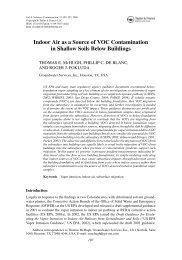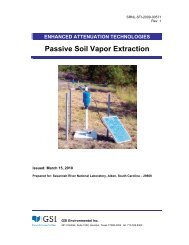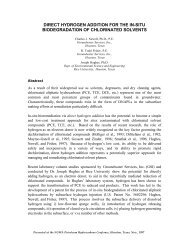Calculation and Use of First-Order Rate Constants for Monitored ...
Calculation and Use of First-Order Rate Constants for Monitored ...
Calculation and Use of First-Order Rate Constants for Monitored ...
Create successful ePaper yourself
Turn your PDF publications into a flip-book with our unique Google optimized e-Paper software.
Bulk Attenuation <strong>Rate</strong> (k) as a Function <strong>of</strong> Longitudinal Dispersivity (α α x)The figures below show the calculation <strong>of</strong> k <strong>for</strong> different dispersivity values as well as a resulting plot <strong>of</strong> bulk attenuation rate as afunction <strong>of</strong> longitudinal dispersivity. The transverse dispersivity (α y) was set to 10% <strong>of</strong> the longitudinal dispersivity (α x), the verticaldispersivity (α z) was set to 10% <strong>of</strong> the transverse dispersivity (α y), <strong>and</strong> t = 30 years. The slopes <strong>of</strong> the concentration vs. distance plotswere multiplied by the contaminant velocity to obtain bulk attenuation rates. This type <strong>of</strong> calculation assumes that the plume is atsteady-state. The figures below suggest that the bulk attenuation rate (k) increases as dispersivity increases.10 x = 3 ft, y = 10.2 e -0.00058xConcentration (mg/L)5 x = 10 ft, y = 8.7 e -0.0011x x = 30 ft, y = 6.6 e -0.0014x x = 100 ft, y = 4.7 e -0.0020x00 200 400 600 800 1000 1200Distance from Source (ft)0.25Bulk rate ( k per year)0.20.150.10.0500 20 40 60 80 100 120 xfeet16






